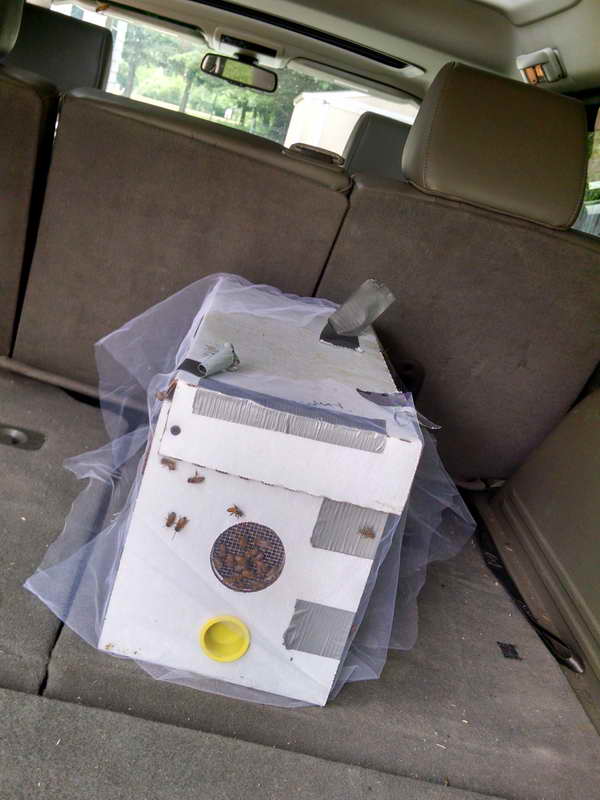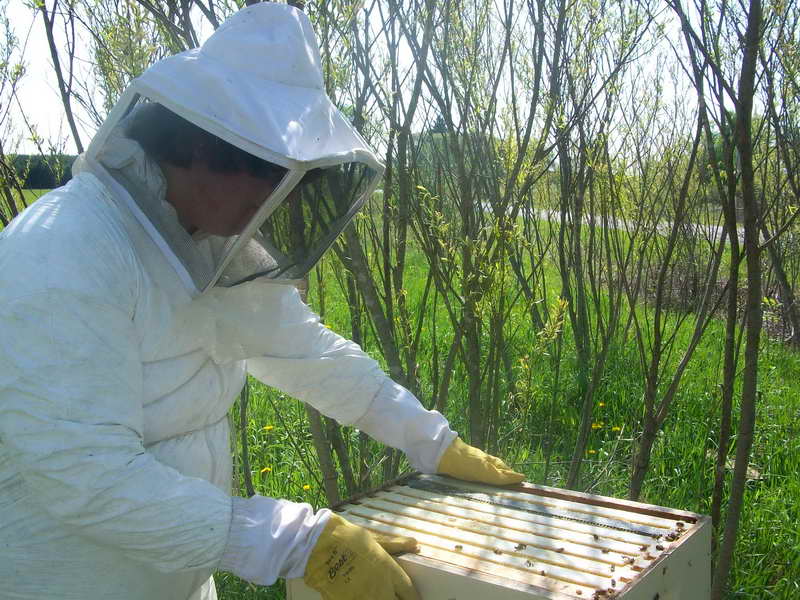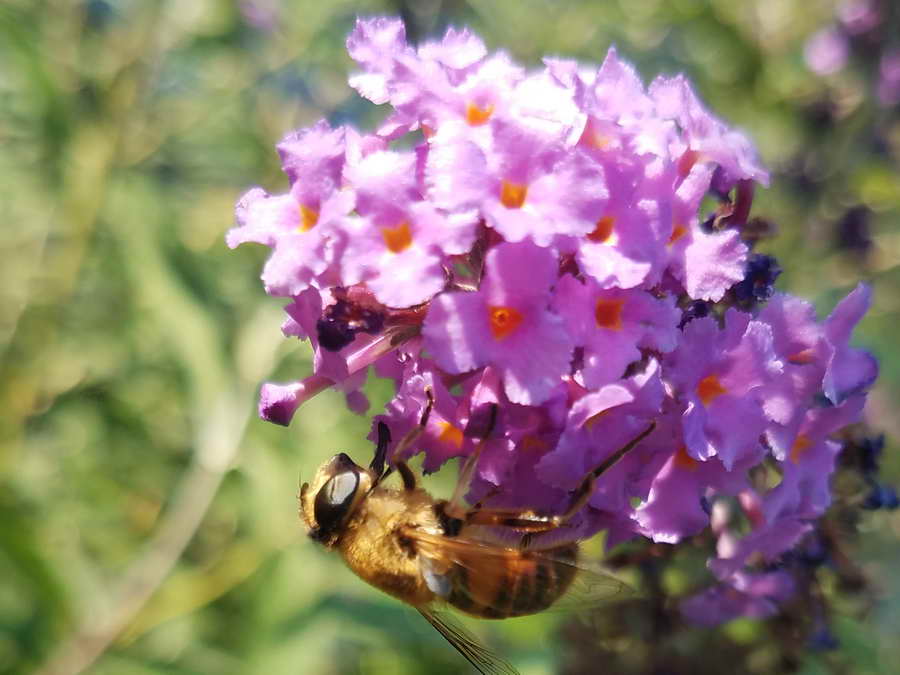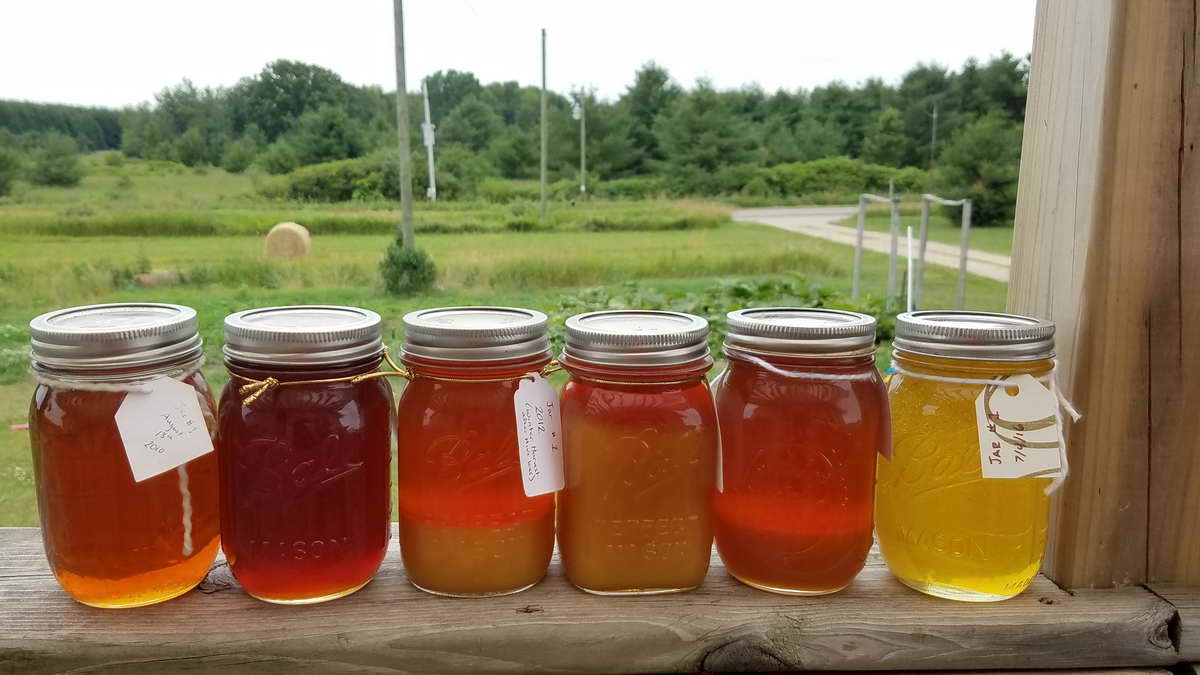Bees take some getting used to, but Lindsey and her husband have been keeping bees, and enjoying the honey, for over a decade. “I think humans, in general, have a very visceral reaction to things that buzz and things that are striped,” mused Lindsey. “It’s terror-inducing. I’ve had bees for 11 years and it’s still scary to me, going out there sometimes. We’re conditioned that something isn’t right if things are buzzing. Rattlesnakes, hornets, you just stay away from buzzing things.”
Beekeeping wasn’t part of Lindsey’s original plan, she got into them by accident. While teaching at a local high school, she came across a University program that brought hives to city schools for the students to tend. She thought it was a great idea, as it seemed the kids developed confidence and a better understanding of the natural world. In order to sell the idea to her principal, though, she would have to learn how to do it herself.
That’s how beekeeping became a thing on their farm. “There is no better way to learn than to bring home 30,000 bees in your car and just do it,” states Lindsey. “That’s what I did. I jumped in with both feet. I bought a bunch of bees and I put them on our property. If you get what is called a nucleus hive, which is what I brought home the first few times, it’s basically a mini hive. It’s usually got five frames of beeswax and honey and brood: eggs and larva and a whole bunch of bees climbing all over it. You take them out of their little cardboard box and you put them into a wooden box where you want them to be.

“The other way you can get bees, which is a lot more dramatic, is called a packaged bee. Packaged bees are in a little wooden cage, with screened sides. There are, literally, a bunch of bees in it. Like, a couple thousand bees and a can of syrup to feed them. The queen is in her own little cage inside of the cage because the queen is foreign to them and they have to get used to her slowly or they will kill her. When you are putting those in a hive, it’s a lot more dramatic because you actually open it up and you shake the living daylights out of the cage and dump them all in.
“Usually around May is when you get your bees, sometimes late April depending on the year, the weather, all that. Then we go ahead and install them, putting them into the box. You can do a mite check and then every few weeks I go out and I look to make sure that they have enough room and I adjust their hives accordingly-adding boxes.”
Little clusters of hive boxes are what people tend to see in fields during the summer. These hives are made up of components with specific purposes. Lindsey explains, “There are generally three sizes of boxes on a beehive. The biggest boxes are generally used for brood, so literally, room for them to make more bees. The medium-sized ones are called honey supers. They are called supers because they are up above.
“Bees like to build up. They will build in the bottom box and then you set another box on and they will crawl up and start building. Then they will start storing their honey during the honey flow when all of the pollen and nectar and stuff is out. They will actually start storing honey into those supers. There are some really short boxes that people use that are specifically for comb honey. When you go to the stores or the farmers market and you see the big chunks of wax that still has the honey in it, that’s called comb honey and that requires a different box because you don’t reuse the wax on those.
“They are smart for insects. The bees are smart enough to have sections for things. Usually, the centre of a frame is going to have the brood, so the worker-sized cells. The outer edges where they have more space, are going to have the brood for the drones. The honey they keep higher up. The honey and the pollen they tend to keep away from the brood chamber.
“The queen cells are kind of cool, they look like morel mushrooms upside down. They are about an inch long and you can tell a lot about the health of the hive based on where those cells are. One tells you that the hive has lost their queen tragically and they had to create this queen in an emergency situation. One tells you that the queen is declining, they know she is on her way out so they raised a new one.”
Beekeeping has also provided Lindsey and her family a window into an alien world. “They just crawl around on the comb all the time. In the winter they go into the cells to cluster together and stay warmer, but generally, those little hexagons are just there for raising more bees or for storing food. They are more like little birthing pods. They live in them for a while while they are growing. The bees will actually remodel inside their honeycomb. Most of the time they are all the same size, but there are some little hexagons that are bigger, and that’s where they raise the boy bees. Honey cells and worker cells are roughly the same size. Drones are bigger and fatter and need more space.”
Tending hives is not a set it and forget it hobby either. Honeybees, which are not native to North America, suffer from a number of ailments. Disease is ever-present and the colonies must be treated for mites and viruses on a regular basis. A sick hive owned by one keeper can spread disease to healthy hives owned by other keepers in the area.

There are other challenges like condensation in the hives, predators, and rodents. The farther north you go, the less adapted the bees are to the cold climate. The clue, she says, is actually in the name. “That’s why they call them Italian Honey bees—because they are not from around here!
The honey bees can be used to enhance pollination in farm fields, but generally, the purpose of beekeeping is to end up with honey. “You do the supering process of putting the honey boxes on for the bees to fill up and when they are full you harvest, which is an interesting process, too. You have bees that are on their honey and you have to get them off of their combs in order to get the honey someplace in which you are going to extract the honey. In my case, it’s my kitchen and I don’t really want bees in my kitchen. Stripey, buzzy, stingy at that pointy end. So you have to get the bees off of those combs.
“There’s three main ways to do that. There is chemical, which I don’t do. You put a fume in the box and it causes them to leave the box. I’m too cheap to do that when the other ways work! The other ways are shaking the bees off of the comb which works pretty well. I do that quite a bit, and, finally, taking a soft-bristled brush and brushing them off of the comb.”
Once the honeycomb is clear of bees, the keeper can begin to extract the honey. Again, there are choices says Lindsey. “There are a couple of different ways of doing it. One is really easy for the beekeeper and requires pretty much no extra equipment. That is just smashing the honeycomb apart and letting it drain. That’s how I did it the first year. Then I learned there was a different way—which required equipment. Therefore, there was more stuff to buy. I bought a honey extractor. It’s like the Gravitron at the county fair, but it’s for honey.
“So you take the comb, the big frame, and you take a knife and you slice off just the top, the capping, of these honeycombs and then the honey is exposed. You do that on both sides and then you put it on this handy-dandy little machine and then you spin it.
“Real honey producers have giant machines that do this. There’s automated machines that do the whole thing. It slices the cappings off, it loads it, it strains it. It does all sorts of things. My version is a hand crank. I either get my children to crank it or else I take a drill and my husband has modified a socket to fit on it and I can power it with a battery drill.
“It’s a lot like how a washing machine spin cycle works. The centrifugal force shoots it all out to the sides of the drum and there’s this drain down at the bottom with a spigot. The actual spinning is a pretty quick process. We usually only run two hives at a time. We’ve had up to six at once. It’s a day’s worth of work to go out there and get the honey and bring it in the house, to slice it open, spin it down and then put the boxes out for the bees to clean up the rest of the way. Everything ends up covered in honey, and the children are constantly stealing pieces of the wax to eat. It’s fun!
“They get a little angry sometimes, yeah,” Lindsey confirms. “That’s not when I usually get stung though! It’s usually when I’m doing other stupid stuff-other than stealing their honey. Weather plays a big part in whether they are angry or not. They’re pretty sensitive to barometric pressure, they don’t really like storms. You don’t want to go out there when it’s about to rain, because they are kind of angry.
“You can tell pretty well by the sound and the smell of the hive if they are mad or not. Bees that are mad put out an alarm pheromone that smells like bananas. It’s strange. I never actually noticed it until I read about it. I was like, “Yeah, they’re right. When they’re mad they smell like bananas. When you squish a bee, it also releases that pheromone which warns the rest of them that squishing could happen and that’s when they start to get a bit defensive.
“I’ve opened up hives wearing shorts and a tank top and no protective gear at all. I’ve been able to take a lid off and look inside. Generally, they are pretty docile. Somewhere I have a picture of one of my kids sitting in his T-shirt and cloth diaper sitting next to the hive. They generally just want to be bees. They are not going to go out of their way to sting you. The times that I have been stung have been situations where there has been a robbing situation going on which is where hornets try to steal honey or larva from the hive.
“In this case, I had the wax left over from harvesting honey and I went to go move it. There were hornets around and when I went to go move it, I got nailed in the arm like three times. My husband has gotten stung a few times when he has tried to pick them up in his hands and put them back in the hive when they swarmed. He got one stuck in his shirt one time which was really dramatic. But generally, they are pretty calm and tame… as tame as an insect can be.”

Beekeeping has become just as much a part of the farm as their other animals. Each year they sell the honey that is produced while the hives continue to contribute to the education of their children and others. “They kind of win people over,” says Lindsey.” I have friends who are terrified of them and absolutely refuse to go even within 10 feet of the hives. I have other friends who are like, ‘oh cool. I’ll put on a suit, let’s go look at them!’”





0 Comments